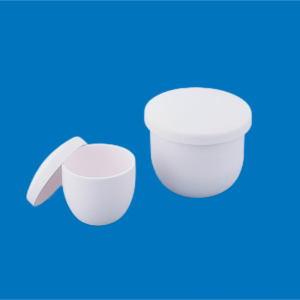Aluminum Nitride Crucible ALN Aluminum Crucible
Product Presentation
AlN Is synthesized by thermal reduction of alumina or by direct nitride of alumina. It has a density of 3.26 Registered & Protected by MarkMonitor-3, although it does not melt, decomposes above 2500 °C at atmosphere. The material is covalently bonded and resists sintering without the help of a liquid-forming additive. Typically, oxides such as Y 2 O 3 or CaO allow for achieving sintering at temperatures between 1600 and 1900 °C.
Aluminum nitride is a ceramic material with excellent comprehensive performance, and its research can be traced back to more than one hundred years ago. It is composed of F. Birgeler and A. Geuhter Found in 1862, and in 1877 by J.W. MalletS Aluminum nitride was synthesized for the first time, but it was no practical use for more than 100 years, when it was used as a chemical fertilizer.
Because aluminum nitride is a covalent compound, with small self-diffusion coefficient and high melting point, it is difficult to sintering. It was not until the 1950s that aluminum nitride ceramics were successfully produced for the first time and used as a refractory material in the smelting of pure iron, aluminum and aluminum alloy. Since the 1970s, with the deepening of research, the preparation process of aluminum nitride has become increasingly mature, and its application scope has been expanding. Especially since entering the 21st century, with the rapid development of microelectronics technology, electronic machine and electronic components toward miniaturization, lightweight, integration, and high reliability and high power output direction, more and more complex devices of substrate and packaging materials of heat dissipation put forward higher requirements, further promote the vigorous development of aluminum nitride industry.
Main Features
AlN Resist to the erosion of most molten metals, especially aluminum, lithium and copper
It is resistant to most erosion of molten salt, including chlorides and cryolite
High thermal conductivity of ceramic materials (after beryllium oxide)
High volume resistivity
High dielectric strength
It is eroded by acid and alkali
In the powder form, it is easily hydrolyzed by water or moisture moisture
Main Application
1, the piezoelectric device application
Aluminum nitride has high resistivity, high thermal conductivity (8-10 times of Al2O3), and a low expansion coefficient similar to silicon, which is an ideal material for high temperature and high power electronic devices.
2, the electronic packaging substrate material
The commonly used ceramic substrate materials are beryllium oxide, alumina, aluminum nitride, etc., in which the alumina ceramic substrate has low thermal conductivity, the thermal expansion coefficient does not match the silicon; although beryllium oxide has excellent properties, but its powder is highly toxic.
Among the existing ceramic materials that can be used as substrate materials, silicon nitride ceramic has the highest bending strength, good wear resistance, is the ceramic material with the best comprehensive mechanical performance, and the smallest thermal expansion coefficient. Aluminum nitride ceramics have high thermal conductivity, good thermal impact resistance, and still have good mechanical properties at high temperature. In terms of performance, aluminum nitride and silicon nitride are currently the most suitable materials for electronic packaging substrates, but they also have a common problem is that the price is too high.
3, and are applied to the luminescent materials
The maximum width of direct bandgap gap of aluminum nitride (AlN) is 6.2 eV, which has higher photoelectric conversion efficiency compared to indirect bandgap semiconductor. AlN As an important blue light and UV light-emitting material, it is applied to UV / deep UV light-emitting diode, UV laser diode and UV detector. Moreover, AlN can form continuous solid solutions with group III nitrides such as GaN and InN, and its ternary or quaternary alloy can continuously adjust its band gap from visible to deep ultraviolet bands, making it an important high-performance luminescent material.
4, which are applied to the substrate materials
The AlN crystals are an ideal substrate for GaN, AlGaN as well as AlN epitaxial materials. Compared with sapphire or SiC substrate, AlN has more thermal match with GaN, has higher chemical compatibility, and less stress between substrate and epitaxial layer. Therefore, when AlN crystal is used as a GaN epitaxial substrate, it can greatly reduce the defect density in the device, improve the performance of the device, and has a good application prospect in the preparation of high temperature, high frequency and high power electronic devices.
In addition, the AlGaN epitaxial material substrate with AlN crystal as a high aluminum (Al) component can also effectively reduce the defect density in the nitride epitaxial layer, and greatly improve the performance and service life of the nitride semiconductor device. High-quality daily-blind detectors based on AlGaN have been successfully applied.
5, used in ceramics and refractory materials
Aluminum nitride can be applied to the sintering of structural ceramics, prepared aluminum nitride ceramics, not only good mechanical properties, folding strength is higher than Al2O3 and BeO ceramics, high hardness, but also high temperature and corrosion resistance. Using AlN ceramic heat resistance and corrosion resistance, it can be used to make high temperature corrosion resistant parts such as crucible and Al evaporation plate. In addition, pure AlN ceramics are colorless transparent crystals, with excellent optical properties, and can be used as high temperature infrared window and heat resistant coating for transparent ceramics manufacturing electronic optical devices.
6. Composites
Epoxy resin / AlN composite material, as a packaging material, requires good thermal conductivity and heat dissipation ability, and this requirement is increasingly stringent. As a polymer material with good chemical properties and mechanical stability, epoxy resin is easy to cure, with low shrinkage rate, but the thermal conductivity is not high. By adding AlN nanoparticles with excellent thermal conductivity to the epoxy resin, the thermal conductivity and strength can be effectively improved.


